Introduction
Exposure of mercury pulled attention of whole world due to its harmful effects. It is a heavy metal and harmful toxic pollutant which has multiple adverse effects. It is commonly used in battery monometer, dental amalgamation, electrical switches, as a catalyst in chemical manufacturing, wood preservative, photography industry, limited use in gold mining and in leather industry although. Furthermore it is heavily used in many industries household product, pharma industry and agriculture industry1, which leads to high dispersion in environment. Bringing in notice over there fatal effect on human health and the environment 2-6. Its effects are nephrotoxic 7, 8, hematotoxic 6, hepatotoxic 8, 9, genotoxic 10, neurotoxic 11 and reduced reproductive strength 12, 13.
Mercury affects antioxidant mechanisms and increase in oxidative stress through the alteration in various mechanism, is possibly resulted in the reduction in Adenosine triphosphate (ATP) content, decrease of antioxidant enzyme activity, depletion of cellular cysteine thiols, mercury has ability to react with Glutathione (GSH, thiol antioxidant) 14 and creates a complex formulation which reduced the antioxidant GSH level in body and results to oxidative stress 15, 16. Oxidative stress leads to impaired transport mechanism, lipid peroxidation, denaturation of protein and DNA 17-20.
Various previous studies reported that plant and plant based products are good source of natural antioxidant that can be used as herbal natural remedy for protection from oxidative stress, plant based treatments has no side effects and has been used since long time 21. Among the various medicinal plants wheatgrass is one which is good source of antioxidant and used globally in various perspectives. Wheatgrass (Triticum aestivum) is a young grass (seven to nine days) of wheat plant. Wheat, (Triticum) species is an annual and biennial cereal grass of the (Poaceae) family, is the world’s largest edible grain cereal grass crop which is widely cultivated almost all over the world. Almost more than twenty five cultivars of wheat are identified in world of which Triticum aestivum is the foremost Indian cultivar of wheatgrass 22. Wheatgrass is a versatile medicinal plant and had been used as a natural medicinal plant from the ancient period of time. In Traditional Indian Ayurvedic system. Wheatgrass is an excellent source of vitamins (A, C, E), minerals (iron, calcium, phosphorus), proteins, enzymes, chlorophyll and other bioactive compounds (Rutin, Chlorophyllin, Apigenin, Quercetin) 23. These nutrients and bioactive compounds increased clinical utility of wheatgrass and makes it a medicinal plant for the treatment of various diseases and life threatening conditions. It has been shown various pharmacological potentials such as anti- cancer activity 24, anti- ulcer activity 25, anti -diabetic activity 26, antioxidant activity 27, anti- thalassemic activity 28 anti- arthritic activity, anti- inflammatory and anti- aging activity 29.These pharmacological potentials were due to presence of various phenolic, flavonoid compounds, vitamins and minerals that makes wheatgrass a sturdy natural therapeutic agent for the prevention of oxidative stress and allied complications with mercuric chloride toxicity. Therefore, the purpose of the experiment was to assess the protective effect of wheatgrass on mercuric chloride induced oxidative stress in rats 1.
Materials and Methods
Chemicals and Reagents
Mercuric chloride (HgCl2, 99.5% purity) was purchased from Sigma-Aldrich Chemical Company India and other required chemicals of analytical grade were procured, Merck India and HIMEDIA Labs, India.
Cultivation of the Wheatgrass
Wheatgrass seeds (cultivar sharbati) were purchased from local market of Allahabad, India. For experimental work wheatgrass was grown at laboratory of Centre of Food Technology, University of Allahabad, U.P. India, by using try method in indoor conditions. Plastic trays were filled with soil contains three parts of soil and one part of organic fertilizer. One night soaked wheat grains were then evenly spread on the surface of the soil and further covered with a thin layer of soil. Spray some water evenly over soil and three to four hours morning sunlight was allowed daily for growth of grass. On the seventh day, grass was harvested. At this stage, wheatgrass is at its nutritional peak 30.
Preparation of Plant Extract
The harvested wheatgrass was shorted and cleaned with water, and then dried in a cabinet tray dryer (Chemida, Mumbai, India) at 55 ± 2 °C for six hours.. After then dried grass was subjected to making fine powder by using a high speed electronic mixer grinder (Sumeet Domestic Plus, M/s. Sumeet, Nashik, India), and passed through fine sieve no. 40.. 10g wheatgrass powder was suspended in 100 ml of ethanol using 250 ml conical flask and kept on orbital shaker for 48 h at 37°C. After 48h, the supernatant was filtered through Whatman filter paper no.1 and lyophilized the sample for drying. The filtrate was then reduced to 1/10th of its initial volume. Obtained lyophilized dried sample was then dissolved in drinking water for dosing and stored at 4 °C for further analysis 31,32.
Experimental Animals
The experiment was carried out with 12 male albino rats (4 to 5 months old) with body weight between 157 ± 51g (IAEC/AU/2017(1)/008). They were housed in a temperature controlled facility (25 ± 5 °C) with 12 h light–dark cycle for one week, at laboratory of Department of Biochemistry, University of Allahabad, U.P. India.. All rats were fed with normal laboratory diet nutrient rich pellets, and had free access to drinking water.
Animal Model and Study Protocol
After the one week of stabilization period, the rats were randomized and grouping three rats were placed in each group, and were given the following dosing:
Group I: Normal control (NC), received no treatment/supplementation.
Group II: Oxidative stressed group (Hg), received HgCl2 (0.5 mg/kg).
Group III: (Hg+WG) group received HgCl2 0.5 mg/kg body weight and wheatgrass extract 100 mg/kg body weight.
Group IV: Normal control group treated with only wheatgrass extract (N+WG) 100 mg/kg body weight.
One hour before treatment with wheatgrass, group III received HgCl2. All the administrations were performed once daily through oral gavage for 30 days. Oxidative stress was induced by administration of mercuric chloride in drinking water at a dose of 0.5mg/kg body weight. The doses of HgCl2 and wheatgrass were selected based on previous studies 33, 34.
Biochemical Assays
After 24 hours of last administration. The rats were sacrificed under light anaesthesia. Blood samples were collected by cardiac puncture into 10 units / ml heparin rinsed anticoagulant syringes. Plasma was obtained from blood sample after centrifugation (1500×g for 10 min) and stored at 4°C for analysis.and then red blood cells were pelleted by centrifugation at 800 g for 10 min at 4°C. After the removal of plasma (immediately frozen at -80°C until use for biochemical assays), buffy coat, and the upper 15% of packed red blood cells (PRBCs), the RBCs were washed twice with cold phosphate buffered saline (PBS) (0.9% NaCl and 10 mmolL–1 Na2HPO4; pH 7.4) and then used for further experiment 35.
Oxidative Stress Markers
Erythrocyte Malondialdehyde (MDA) was measured using the thiobarbituric acid (TBA) method 36. Estimation of Advanced oxidation protein products (AOPP) levels in plasma was performed by spectrophotometric detection method 37, 38. The activity of the erythrocyte Plasma membrane redox system (PMRS) was measured by the reduction of ferricyanide the method 39.
Antioxidant Status
Glutathione (GSH) was estimated by 5,5’-dithiobis (2- nitrobenzoic acid) (DTNB) method it is based on the ability of the SH group to reduce DTNB and form a yellow coloured anionic product whose optical density is measured at 412 nm 40, 41. The Ferric reducing antioxidant activity of the plasma samples was determined using Ferric reducing antioxidant power (FRAP) assay 42, 43. Radical scavenging capacity of plasma samples were estimated by 2, 2- diphenyl -1- picrylhydrazyl (DPPH) reduction assay 44, 45.
Lipid Profile, Liver and Kidney Functions Tests
Lipid profiles (Total cholesterol, triglyceride and LDL-Cholesterol), liver function parameters such as (Plasma Alkaline phosphatase (ALP), Aspartate aminotransferase (AST), and Alanine aminotransferase (ALT) were measured in serum using kits from (Erba Diagnostics, Mannheim, Germany). Kidney dysfunction test (Serum Urea and Creatinine) were assayed using the kit from (Span Diagnostic Ltd.Surat, India) 46, 47.
Statistical Analysis
Statistical analyses were performed using one way ANOVA followed by Tukey’s Multiple Comparison Test. P< 0.05 was considered to be statistically significant with Graph Pad Software, San Diego California USA version 5.01 for Windows. Results were expressed as the mean ±S.D.
Results and Discussion
Mercuric chloride is the one of the most harmful toxic pollutant of the world, excess accumulation of mercuric chloride in human body poses various adverse changes. It leads to formation of free radicals that cause oxidative stress and other associated complications such as hepato–nephrotoxicity48-,50, mental retardation, 51 and heart problems52.
In this study, protective role of wheatgrass extract was investigated in rat model against oxidative stress induced by HgCl2. Wheatgrass aqueous extract act as a quencher of free radicals and neutralizing those 14, 53. Therefore, it is concluded that the wheatgrass reduces the adverse consequences of HgCl2 induced oxidative stress through countering the excessive radicals of all major types. The present study demonstrated that after 30 days of oral administration of wheatgrass extract, the antioxidant status (GSH, FRAP, DPPH) of stressed rats were significantly elevated. On the other hand reduction in lipid profiles (TC,TG,LDL), kidney function tests (urea, creatinine), liver function tests (ALP, AST, ALT) and oxidative stress markers ( MDA, AOPP, PMRS) was observed in the HgCl2 -induced oxidative stressed rats. The results of the study revealed that wheatgrass protects the antioxidant defense system by activating antioxidant enzymes and reduced mercury-induced oxidative stress by scavenging free radical in-vivo conditions.
Evaluation of the plasma antioxidant capacity (GSH, FRAP and DPPH) is the primary step in the prophecy of oxidative stress in various pathological conditions such as heart diseases, hepato- nephrotoxicity, cancer, Alzheimer disease and hyperglycemia 54. The result of the experiment shows that, the reduced glutathione (GSH), FRAP and DPPH levels significantly decreased in HgCl2-treated rats in comparison to the normal control rats (P < 0.001) Figure 1,2,3. Conversely finding of the study showed that oral supplementation with wheatgrass extract significantly increased (P < 0.001) the antioxidant status (GSH, FRAP and DPPH) level as noticed in the Hg+WG treated groups in comparison to HgCl2-treated rats and this might be as a result of the wheatgrass extract containing polyphenols, flavonoid, chlorophyll, vitamin A, vitamin C, and vitamin E, all these bioactive compounds poses good antioxidant capacity and makes wheatgrass a strong antioxidant agent 27,55.
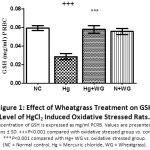 |
Figure 1: Effect of Wheatgrass Treatment on GSH Level of HgCl2 Induced Oxidative Stressed Rats. |
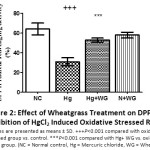 |
Figure 2: Effect of Wheatgrass Treatment on DPPH % Inhibition of HgCl2 Induced Oxidative Stressed Rats. |
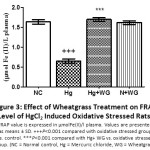 |
Figure 3: Effect of Wheatgrass Treatment on FRAP Level of HgCl2 Induced Oxidative Stressed Rats. |
HgCl2 causes the generation of free radicals, reactive oxygen species (ROS) are highly responsible for the lipid peroxidation of biological membranes, involves decomposition of fatty acids especially (PUFA), production of 4-hydroxynonenal (4HNE) and malondialdehyde (MDA). Lipid oxidation products, such as MDA reacts with proteins, DNA, phospholipids modify RNA, and other biomolecules, another product 4HNE, is hepatotoxic, cytotoxic, genotoxic, mutagenic and induce dysfunction of immune systems. MDA are mostly used parameter for the estimation of the lipid peroxidation by reactive oxygen species (ROS) 56. The result of the study demonstrated that HgCl2 administrated group significantly (P < 0.01) enhance in MDA level in comparison with the control group. After wheatgrass treatment MDA level was significantly (P < 0.01) decrease in Hg+WG group when compare with HgCl2 treated group 57 Figure 4.
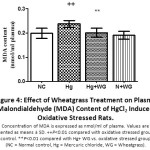 |
Figure 4: Effect of Wheatgrass Treatment on Plasma Malondialdehyde (MDA) Content of HgCl2 Induced Oxidative Stressed Rats. |
Plasma membrane redox system (PMRS) of Red blood cells (RBCs) transfers electrons from intracellular substrates to extracellular electron acceptors 40 neutralization of oxidative stress, recycling of ascorbic acid and regulating of normal energy metabolism 58-60. It has been observing in various clinical studies that elevated level of PMRS was found in the erythrocytes during oxidative stress and associated condition such as diabetic nephropathy, type 2 diabetes mellitus and during aging in humans 61. The result of the present study reveled that HgCl2 administration significantly (P < 0.001) increased level of erythrocyte PMRS in HgCl2 treated rats when compare to control group. However, after wheatgrass supplementation the PMRS activity was significantly decreased in Hg+WG treated group as compare to HgCl2-treated group (P < 0.001) Figure 5. . Elevated level in erythrocyte PMRS activity in HgCl2 treated rats is the indication of excess production of free radicals. Wheatgrass supplementation restored PMRS activity near to normal level, through the scavenging of free radicals and improving the antioxidant system55.
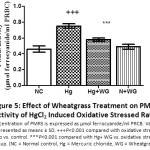 |
Figure 5: Effect of Wheatgrass Treatment on PMRS Activity of HgCl2 Induced Oxidative Stressed Rats. |
AOPPs are the biomarkers to estimate the degree of oxidative modifications of proteins 32. Various pathological conditions such as oxidative stress, hepatotoxicity, kidney disease, diabetes, mental retardation, and muscular dystrophy are associated with excess accumulation of the protein products (AOPPs) 62, 63. In this study researcher observed a significantly (P < 0.001) increased formation of AOPP and protein oxidation in mercuric chloride administered rats as compared to control rats. Present study reveled that after the wheatgrass extract supplementation protein oxidation level was significantly decreased (P < 0.001) in Hg+WG rats in comparison with HgCl2-treated rats, Figure 6. Therefore, it could be conclude that wheatgrass demonstrated considerable antioxidant efficacy against protein oxidation influence by oxidative stress.
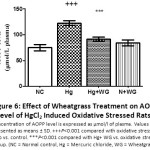 |
Figure 6: Effect of Wheatgrass Treatment on AOPP Level of HgCl2 Induced Oxidative Stressed Rats. |
Oxidative stress is generally associated with increased formation of free radicals, responsible for the lipid peroxidation; lipid peroxidation makes possible occurrence of cardiac necrosis and accrual of lipids, which leads to injure of cardiac tissues. Cardiac tissue damage induced by HgCl2 in rats was indicated by elevated level of the lipid profile. Elevated level of lipid profile (plasma triglycerides, total cholesterol, LDL-S) in the HgCl2 treated group demonstrated that HgCl2 may be interfering with metabolism or biosynthesis of lipids 64,65.
Results showed that HgCl2 caused adverse alterations in lipid profiles. Mercuric chloride significantly increased (p < 0.001) cholesterol, LDL and triglycerides levels in HgCl2 treated rats as compared to control group. Administration of wheatgrass extract has significantly reduced (p < 0.001) elevated TC, LDL and triglycerides levels in Hg+WG treated group as comparison to HgCl2-treated group, Figure 7,8,9. . These findings are in parallel with the other experimental studies 66, 67.These changes in lipid profile after wheatgrass treatment may be the presence of its bioactive compounds, flavonoids triterpenoids and tannins, which are reported to lipid lowering effect in many more scientific studies. Wheatgrass supplementation was proficient to condense the HgCl2 induced cardiotoxicity, shows by various ways. Gamma sitosterol an active component of wheatgrass has been reported to persuade cholesterol synthesis in liver and intestine 54. Studies reveled that anti-platelet aggregation was shown by caryophyllene and its oxides, are active biological components of wheatgrass 68. Another wheatgrass compounds alpha and beta amyrins are the two biologically active penta cyclic triterpenes, have anti-hyperglycemic effect and hypolipidemic effect and suggesting that this compound is a potential candidate for diabetes and atherosclerosis 69. This proves that wheatgrass is very efficient in lowering the lipid levels in rats. To conclude, the present result suggests that wheatgrass extract can be used as a lipid lowering agent and as a primary therapy in treating cardiovascular diseases.
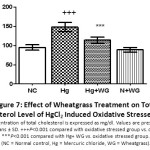 |
Figure 7: Effect of Wheatgrass Treatment on Total Cholesterol Level of HgCl2 Induced Oxidative Stressed Rats. |
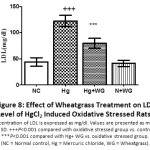 |
Figure 8: Effect of Wheatgrass Treatment on LDL Level of HgCl2 Induced Oxidative Stressed Rats. |
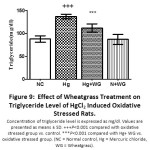 |
Figure 9: Effect of Wheatgrass Treatment on Triglyceride Level of HgCl2 Induced Oxidative Stressed Rats. |
Serum urea and creatinine tests are basic parameters of kidney dysfunctions test 14. By the previous studies it was proved that that kidneys functions are the badly altered by the induction of HgCl2, because Hg accumulates more in kidneys 70. In the present study, enhanced levels of serum creatinine and urea in HgCl2-treated group indicate the renal dysfunction and nephrotoxicity 71. This elevation in serum creatinine and urea might be due to damage in renal tissues and alteration in renal functions. Similar findings have stated by the other previous studies 10,15,72,73. The results demonstrate that increased serum urea and creatinine level was observed in HgCl2– induced stressed rats in comparison with the control rats, (p < 0.001), (p < 0.01) respectively. On the other hand, treatment with wheatgrass extract at dose 100 mg/kg body weight showed a significant reduction (p < 0.05) in the levels of serum urea and creatinine in Hg+WG treated group as compared to the HgCl2-treated group 14Figure 10,11. Findings of the study showed that wheatgrass extract improved HgCl2-induced nephrotoxicity; this is due to the antioxidant potential of wheatgrass to quenching free radicals. The antioxidant attributes of wheatgrass was proved by the previous studies, which showed that wheatgrass has a great efficiency for scavenging of ROS as metal chelating agent, and inhibits lipid peroxidation 15. The antioxidant efficacies of aqueous extract of wheatgrass and suggest that it may be used as a therapeutic agent in the prevention of renal toxicity caused by Hg 74.
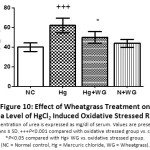 |
Figure 10: Effect of Wheatgrass Treatment on Urea Level of HgCl2 Induced Oxidative Stressed Rats. |
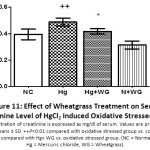 |
Figure 11: Effect of Wheatgrass Treatment on Serum Creatinine Level of HgCl2 Induced Oxidative Stressed Rats. |
ALP, AST and ALT are the enzymes produced by the liver and all body tissues including muscles, heart, kidney and brain with higher amounts in the liver. Raised levels of these enzymes are the reasonably sensitive indicators of liver damage and tissue injury, where damaged liver cells liberate these enzymes in to the blood circulation and their levels get increased. Elevated levels of these enzymes in stressed conditions, is the initial identification of oxidative stress induced by mercury, which supports the results of this study, our results demonstrated that, liver enzymes (ALP, AST and ALT) levels were augmented in the stressed induced group that confirms occurrence of hepatotoxicity75. Therefore it is concluded that Hg causes hepatotoxicity 10,76
To estimate the efficacy of wheatgrass extract on HgCl2 -induced hepatic toxicity, liver function tests were measured after wheatgrass supplementation in the serum of HgCl2 treated rats. The finding of the study demonstrated that, HgCl2 administration caused increases (p < 0.001) in liver enzymes; ALP, AST and ALT levels, when compare to control rats, while after the supplementation with wheatgrass extract remarkably inhibited HgCl2 -induced liver damage, improved liver functions in Hg+WG treated group when compare to HgCl2-treated group as evidenced by significantly decreased activities of liver enzymes and restored the almost normal serum ALP, AST and ALT levels (p < 0.001), (p < 0.05), and (p < 0.001) respectively, Figure 12,13,14.. Findings of the study were in agreement with previous studies, demonstrated hepatoprotective potential of wheatgrass 77, 78. Wheatgrass and its phytochemicals such as flavonoids, phenols, phytol, sitosterol, squalene, especially alpha and beta amyrins (penta cyclic triterpenes) might be responsible for hepatoprotective potential that improves liver function activities 79, 80.
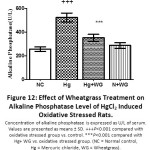 |
Figure 12: Effect of Wheatgrass Treatment on Alkaline Phosphatase Level of HgCl2 Induced Oxidative Stressed Rats. |
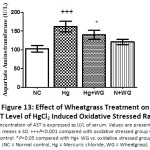 |
Figure 13: Effect of Wheatgrass Treatment on AST Level of HgCl2 Induced Oxidative Stressed Rats. |
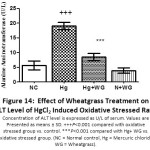 |
Figure 14: Effect of Wheatgrass Treatment on ALT Level of HgCl2 Induced Oxidative Stressed Rats. |
Conclusion
The results of the present study was concludes that wheatgrass act as an efficient antioxidant agent which was confirmed by the findings of the study. Administration of HgCl2 caused oxidative stress was proved by the elevated levels of PMRS, MDA, AOPP, ALP, AST, ALT serum urea, creatinine, TC, TG, LDL simultaneously treatment with wheatgrass significantly improved the antioxidant status-DPPH, FRAP, GHS, hence wheatgrass extract has great potential to improve the antioxidant status and provide protection against mercuric chloride induced oxidative stress and associated complications.
Acknowledgements
The authors acknowledges University of Allahabad for supporting this work.
Funding Sources
The author (s) received UGC-CRET fellowship for this research work.
Conflict of Interest
No conflicts of interest to disclose.
References
- Joshi D., Mittal D., Shukla S., Srivastav S., Dixit V. Curcuma longa Linn, extract and curcumin protect CYP 2E1 enzymatic activity against mercuric chloride-induced hepatotoxicity and oxidative stress: A protective approach. Toxicol. Pathol. 2017; 69(6):373-382.
CrossRef - Nevado J.B., Martín-Doimeadios R.R., Bernardo F.G., Moreno M.J., Herculano A.M., Do Nascimento J., Crespo-López M.E. Mercury in the Tapajós River basin, Brazilian Amazon: a review. Int. 2010; 36(6): 593-608.
CrossRef - Raghuvanshi R., Chaudhari A., Kumar GN. Amelioration of cadmium- and mercury induced liver and kidney damage in rats by genetically engineered probiotic Escherichia coli Nissle 1917 producing pyrroloquinoline quinone with oral supplementation of citric acid. 2016; 32(11–12):1285–94.
CrossRef - Joshi D., Mittal D.K., Kumar R., Srivastav AK., Srivastav S.K. Protective role of Curcuma longa extract and curcumin on mercuric chloride-induced nephrotoxicity in rats: evidence by histological architecture. Environ. Chem. 2013; 95 (9):1581–1588.
CrossRef - Altunkaynak ME., Akgul N., Yahyazadeh A., Altunkaynak BZ., Turkmen AP., Akgul HM., Aksak S., Unal B. A stereological and histopathological study of the effects of exposure of male rat testes to mercury vapor. Histochem. 2015; 90 (7):529–34.
CrossRef - Crowe W., Allsopp P.J., Watson G.E., Magee P.J., Strain J., Armstrong D.J., Ball E., McSorley E.M. Mercury as an environmental stimulus in the development of autoimmunity–a systematic review. Rev. 2017; 16(1): 72-80.
CrossRef - Durak D., Kalender S., Uzun FG., Demvr F., Kalender Y. Mercury chloride-induced oxidative stress in human erythrocytes and the effect of vitamins C and E in vitro. J. Biotechnol. 2010;9(4):488–95.
- Aslanturk A., Uzunhisarcikli M., Kalender S., Demir F. Sodium selenite and vitamin E in preventing mercuric chloride induced renal toxicity in rats. Food Chem. Toxicol. 2014; (70):185–90.
CrossRef - Joshi D., Mittal DK., Shukla S., Srivastav AK., Srivastav SK. N-acetyl cysteine and selenium protects mercuric chloride-induced oxidative stress and antioxidant defense system in liver and kidney of rats: a histopathological approach. Trace Elem. Med. Biol. 2014; (28):218–26.
CrossRef - Othman MS., Safwat G., Aboulkhair M., Abdel Moneim AE. The potential effect of berberine in mercury induced hepatorenal toxicity in albino rats oxygen species and its effect on antioxidant enzymes in different regions of rat brain. Environ. Sci. Health. 2014; (32): 395-09.
CrossRef - Rozgaj R., Kasuba V., Blanus M. Mercury chloride genotoxicity in rats following oral exposure, evaluated by comet assay and micronucleus test. Hig. Rada Toksikol. 2005; (56): 9–15.
- Moraes-Silva L., Siqueira LF., Oliveira VA., Oliveira CS., Ineu RP., Pedroso TF., Fonseca MM., Pereira ME. Preventive effect of CuCl(2) on behavioral alterations and mercury accumulation in central nervous system induced by HgCl2 in newborn rats. Biochem. Mol. Toxicol.2014; (28): 328-335.
CrossRef - Zhang QF., Li YW., Liu ZH., Chen QL. Reproductive toxicity of inorganic mercury exposure in adult zebrafish: histological damage, oxidative stress, and alterations of sex hormone and gene expression in the hypothalamic-pituitary gonadal axis. Toxicol. 2016; (177):417–24.
CrossRef - Caglayan C., Kandemir F.M., Yildirim S., Kucukler S., Eser G. Rutin protects mercuric chloride-induced nephrotoxicity via targeting of aquaporin 1 level, oxidative stress, apoptosis and inflammation in rats. Trace. Elem. Med. Biol. 2019; (54):69-78.
CrossRef - Gado AM., Aldahmash BA. Antioxidant effect of Arabic gum against mercuric chloride-induced nephrotoxicity. Des. Devel. Ther. 2013; (7):1245-1252.
CrossRef - Deng Y., Xu ZF., Liu W., Xu B., Yang HB., Wei YG. Riluzole-triggered GSH synthesis via activation of glutamate transporters to antagonize methyl mercury-induced oxidative stress in rat cerebral cortex. Med .Cell .Longev. 2012; 1-12.
CrossRef - Kalender S., Uzun F.G., Demir F., Uzunhisarcıklı M., Aslanturk A. Mercuric chlorideinduced testicular toxicity in rats and the protective role of sodium selenite and vitamin E. Food Chem. Toxicol. 2013; (55): 456-462.
CrossRef - Stohs S., Bagchi D. Oxidative mechanisms in the toxicity of metal ions. Free Radic Biol Med. 1995; (18): 321-336.
CrossRef - Gulçin I. Antioxidant activity of food constituents: an overview. Toxicol. 2012; 86(3): 345-391.
CrossRef - Kirici M., Turk C., Caglayan C. Toxic effects of copper sulphate pentahydrate on antioxidant enzyme activities and lipid peroxidation of freshwater fish capoeta umbla (heckel, 1843) tissues. Ecol. Environ. Res. 2017; (15):1685-1696.
CrossRef - Patrick L. Mercury toxicity and antioxidants: Part 1: role of glutathione and alpha-lipoic acid in the treatment of mercury toxicity. Altern Med Rev. 2002; (7): 456-471.
- Jain B., Jain N. Nutitional Composition, Phyto chemical Analysis Product Development From Green Food Triticum Aestivum. Indi J. of Ancient Med and Yoga. 2014; 7(1):23-27.
- Chaturvedi, N., Sharma, P., Rohtagi, S. Preliminary phytochemical, nutritional potential of cereal grass powder based products for effective management of diabetes. J. of Adv. in Pharm, Bio and Chem. 2013; 2(1): 234-240.
- Bharathi E., Jagadeesan G. Antioxidant potential of hesperidin and ellagic acid on renal toxicity induced by mercuric chloride in rats. Biomed & Preve. Nutr. 2014; 4(2): 131-136.
CrossRef - Lai CN., Dabney B., Shaw C. Inhibition of In vitro metabolic activation of carcinogens by wheat sprout extracts. & Cancer. 1978; 1(1): 27–30.
CrossRef - Ben-Arye E., Goldin E., Wengrower D., Stamper A., Kohn R., Berry E. Wheat grass extract Juice in the Treatment of Active Distal Ulcerative Colitis: A Randomized Doubleblind Placebo-controlled Trial. Scandinavian jour. of gastroentero. 2002; 37(4): 444–449.
CrossRef - Yogesha M., Jesuthankaraj G.N., Thangavelu N. R. Antidiabetic and Antioxidant Properties of Triticum aestivum in Streptozotocin-Induced Diabetic Rats. Advanc in Pharmacol Scienc. 2013; Article ID 716073.
CrossRef - Kulkarni SD., Tilak JC., Acharya R., Rajurkar NS., Devasagayam TP., Reddy AV. Evaluation of the antioxidant activity of wheatgrass (Triticum aestivum L.) as a function of growth under different conditions. Phytother Res. 2006; 20(3): 218–227.
CrossRef - Marwaha RK., Bansal D., Kaur S., Trehan A. Wheat grass extract Juice Reduces Transfusion Requirement in Patients with Thalassemia Major: A Pilot Study. Pediatr. 2004; (41): 716–720.
- Jain and Argal. Pharmacognostic and phytochemical investigation of young leaves of Triticum aestivum Linn. Curr. Pharmace. J. 2014; 3(6): 280-285.
CrossRef - Urmila K. Dholi. Phytochemical screening and estimation of nutritional content of wheatgrass powder and wheatgrass juice. World J. of Pharmace. Res. 2018; 7(15): 882-895.
- İlhami G. The antioxidant and radical scavenging activities of black pepper (Piper nigrum ) seeds. Int. J. of Food Sci. & Nutri. 2009; (56): 491-499.
CrossRef - Nenonen MT., Helve TA., Rauma AL., Hanninen OO. Uncooked, Lactobacilli-rich, Vegan Food and Rheumatoid Arthritis. Brit. J. of Rheumatology.1998; (37): 274– 281.
CrossRef - Jafari M., Rezaei M., Kalantari H., Hashemitabar M. Determination of Cell Death Induced by Lovastatin on Human Colon Cell Line HT29 Using the Comet Assay. Jundishapur J. Nat. Pharm. Prod. 2013;(8):187–91.
CrossRef - Kumar D., Rizvi S.I. Black tea supplementation augments redox balance in rats: relevance to aging. Arch. of Phys. & Biochem. 2013; 123(4):212-218.
CrossRef - Mansouri MT., Farbood Y., Sameri MJ., Sarkaki A, Naghizadeh B, Rafeirad M. Neuroprotective effects of oral gallic acid against oxidative stress induced by 6 hydroxydopamine in rats. Food Chem. 2013; 138(2):1028–33.
CrossRef - Dileep Kumar D., Syed Ibrahim Rizvi S.I. Black tea extract improves anti-oxidant profile in experimental diabetic rats. Arch. of Phys. & Biochem. 2015; 121(3):109-115.
CrossRef - Esterbauer H., Cheeseman K.H. Determination of aldehydic lipid peroxidation products: malondialdehyde and 4-hydroxynonenal. Methods Enzymol.1990; (186): 407–13.
CrossRef - WItko-Sarsat V., Gausson V., Deschamps-Latscha B. Are advanced oxidation protein products potential uremic toxins. Kidney Int. 2003; 63 (S84): S11-S14.
CrossRef - Rizvi SI., Jha R., Maurya PK. Erythrocyte plasma membrane redox system in human aging. Rejuv. Res. 2006; (9): 470–474.
CrossRef - Jaiswal N., Kumar D., Rizvi S.I. Red onion extract (Allium cepa L.) supplementation improves redox balance in oxidatively stressed rats. Food Sci & Human Wellness. 2013; (2): 99–104.
CrossRef - Beutler E. A Manual of Biochemical Methods. Grunne and Stratton, New York. 1984.
- Tiwari B.K., Pandey K.B, Jaiswal N., Abidi A.B., Rizvi S.I. Antidiabetic and anti-oxidative effect of composite extract of leaves of some Indian plants on alloxan induced diabetic wistar rats. J. of Pharma. Invest. 2014; 44(3):205-211.
CrossRef - Benzie I.F.F., Strain J.J. The ferric reducing ability of plasma (FRAP) as a measure of ‘‘Antioxidant Power’’: The FRAP assay. Anal. Biochem. 1996; (239) 70-76.
CrossRef - Pandey K.B. Protein oxidation biomarkers in plasma of type 2 diabetic patients. Clin Biochem. 2010; 43(4-5):508-11.
CrossRef - Janaszewska, A., Bartosz G. Assay of total antioxidant capacity: comparison of four methods as applied to human blood plasma. Scand. Jour. Clin. Lab. Investig. 2002; (62): 231-236.
CrossRef - Wybenga D.R., Di-Giorgio, J., Pileggi, V.J. 1971. Manual and automated methods for urea nitrogen measurement in whole serum. Clin. Chem. 1971; (17): 891–895.
CrossRef - Chromy V., Rozkosna K., Sedlak P. Determination of serum creatinine by Jaffe method and how to calibrate to eliminate matrix interference problems. Clin. Chem. Lab. Med. 2008; (46): 1127–1133.
CrossRef - El-Shenawy SM., Hassan NS. Comparative evaluation of the protective effect of selenium and garlic against liver and kidney damage induced by mercury chloride in the rats. Pharmacol. Rep. 2008; 60(2):199-08.
- Deng Y., Xu Z., Liu W., Yang H., Xu B., Wei Y. Effects of lycopene and proanthocyanidins on hepatotoxicity induced by mercuric chloride in rats. Biol. Trace Elem. Res. 2012; 146 (2):213–23.
CrossRef - Sener G., Sehirli O., Tozan A.,Velioglu-Ovunç A., Gedik N., Omurtag G.Z. Ginkgo biloba extract protects against mercury (II)-induced oxidative tissue damage in rats. Food. Chem. Toxicol. 2007; 45(4):543-550.
CrossRef - El-Desoky G.E., Bashandy S.A., Alhazza I.M., Al-Othman Z.A., Aboul-Soud M.A., Yusuf K. Improvement of mercuric chloride-induced testis injuries and sperm quality deteriorations by Spirulina platensis in rats. 2013; PLoS One 8(3): e-59177.
CrossRef - Azevedo B.F., Neto H.d.A.F., Stefanon I., Vassallo D.V. Acute cardiorespiratory effects of intracisternal injections of mercuric chloride. Neurotoxicology. 2011; 32(3): 350-354.
CrossRef - Goudarzi M., Kalantar M., Kalantar H. The Hepatoprotective Effect of Gallic Acid on Mercuric Chloride-Induced Liver Damage in Rats. J. Nat. Pharm. 2017; 12(4):e12345.
CrossRef - Yang F, Basu TK, Ooraikul B. Studies on germination conditions and antioxidant content of wheatgrass. Int J Food Sci Nutr 2001; 52:319–330.
CrossRef - Durairaj V., Muddasarul H., Garima S., Sankar P., Preedia B., Rukkumani R. Phytochemical screening and analysis of antioxidant properties of aqueous extract of wheatgrass. Asian Paci. J. of Trop. Medic. 2014; 7(1): S398-S404.
CrossRef - Radhey S., Som N. S., Praveen V., Vijay K. S., Rajeev B., Shashi B. S., Pratul K. B. Wheat Grass Supplementation Decreases Oxidative Stress in Healthy Subjects: A Comparative Study with Spirulina. The J. of Altern and Complemen Med. 2007; 13, ( 8): 789-791.
CrossRef - Radhey S., Som N. S., Praveen V., Vijay K. S., Rajeev B., Shashi B. S., Pratul K. B. Wheat Grass Supplementation Decreases Oxidative Stress in Healthy Subjects: A Comparative Study with Spirulina. The J. of Altern and Complemen Med. 2007; 13, ( 8): 789-791.
CrossRef - Hyun DH., Emerson SS., Jo DG., Mattson MP., de Cabo R. Calorie restriction up-regulates the plasma membrane redox system in brain cells and suppresses oxidative stress during aging. Proc Natl Acad Sci USA, 2006a; (103): 19908–19912.
CrossRef - Rizvi SI., Srivastava N. Erythrocyte plasma membrane redox system in first degree relatives of type 2 diabetic patients. Int. J. Diabetes Mellitus.2010; (2): 119–121.
CrossRef
- Berlett BS., Stadtman ER. (1997). Protein oxidation in aging, disease, and oxidative stress. J Biol Chem, 1997; (272): 20313–20316.
CrossRef - Kumar D., Sharma B., Rizvi S.I. Protective role of black tea and vitamin C during sub-acute toxicity of carbofuran in rats. Progr. In Health Scie. 2016; 6 (2): 148.
CrossRef - Griendling KK., Alexander RW. Oxidative stress and cardiovascular damage during ischaemia and reperfusion: role of the cellular disease. Circulation. 1997; 96(10):3264-3265.
- Hamberg M., Svensson J., Wakabayashi T., Samuelsson B. Isolation and structure of two prostaglandin endoperoxides that cause platelet aggregation. Proc Natl Acad Sci. 1974; 71(2):345-349.
CrossRef - Kothari S., Jain KA., Mehta CS., Tonpay DS. Effect of fresh Triticum aestivum grass juice on lipid profile of normal rats. Ind. J.of Pharmacol. 2008; 40(5): 235-236.
CrossRef - Zelina Iknur SM., Ismat O., Yetkin Y., Ibrum GO. The Investiga-tion of the Antioxidative Properties organoselenium Compound in Some Rat Tissues. Experi Bio and Medic. 2008; (233): 575-579.
CrossRef - Sethi J., Yadav M., Dahiya K., Sood S., Singh V., Bhattacharya SB. (2010) Antioxidant effect of Triticum aestivium (wheatgrass) in high-fat diet-induced oxidative stress in rabbits. Methods Find Experi Clinil Pharmacol. 2010: 32(4): 233-235.
CrossRef - Ho SS., Pal S. Margarine Phytosterols Decrease the Secretion of Atherogenic Lipoproteins from Hepg2 Liver and Caco2 Intestinal Cells. Atherosclerosis. 2005; 182(1):29-36.
CrossRef - Lin Q., Zou X., Fang L., Willis WD. Sympathetic modulation of acute cutaneous flare induced by intradermal injection of capsaicin in anesthetized rats. J Neurophysiol. 2003; (89):853-861.
CrossRef - Santos FA., Frota JT., Arruda BR., Melo TS., Silva AACA., Brito GAC. Antihyperglycemic and hipolidemic effects of α,β-amyrin, a triterpenoid mixture from Protium heptaphyllum in mice. Lipids in Health & Disease. 2012; (11):98-105.
CrossRef - Bayomy., Naglaa A., Eman Z., Abdelaziz., Mona A.S., Marwa S., Badawi., Reda H El-Bakary. Effect of pycnogenol and spirulina on vancomycin induced renal cortical oxidative stress, apoptosis and autophagy in adult male albino rat. Can J. Physiol Pharmacol. 2016; 94(8):838-48.
CrossRef - Franciscato C., Moraes-Silva L., Duarte F.A., Oliveira C.S., Ineu, R.P., Flores, E.M., Dressler., V.L., Peixoto, N.C., Pereira, M.E. Delayed biochemical changes induced by mercury intoxication are prevented by zinc pre-exposure. Ecotoxicol. Environ. Saf. 2011; (74), 480–486.
CrossRef - Tanaka-Kagawa T., Suzuki M., Naganuma A., Yamanaka N., Imura N. Strain difference in sensitivity of mice to renal toxicity of inorganic mercury. J Pharmacol Exp Ther. 1998; (285): 335-341.
- Abdel-Motaal M. Fouda. Thymoquinone Ameliorates Renal Oxidative Damage and Proliferative Response Induced by Mercuric Chloride in Rats. Basic & Clini. Pharmaco. & Toxico. 2008; (103):109-118.
CrossRef - Pena C., Juan P., Fonseca H., Pedreañez A., Viera N., Mosquera J. Renal oxidative stress and renal CD8 T-cell infiltration in mercuric chloride-induced nephropathy in rats: role of angiotensin II. J. of Immunotoxico 2016; 13 (3): 324-34.
CrossRef
- Emanuelli T., Rocha JB., Pereira ME., Porciuncula LO., Morsch VM., Martins AF., Souza DO. Effect of mercuric chloride intoxication and dimercaprol treatment on delta-aminolevulinate dehydratase from brain, liver and kidney of adult mice. Pharmacol Toxicol, 1996; (79): 136-143.
CrossRef - Ejebe D.E., Nwokocha C., Nwangwa E.K., Ekene N., Akonoghrere R., Ukwu, J. The effects of Bitter Kola supplemented diet on hepatotoxicity of mercury in Wistar rats. Jour. Appl Sci Environ. Manage. 2010; (14): 89–95.
CrossRef - Jain G., Argal A., Pathak AK., Singh VK., Kannojia P. Hepatopro-tective activity of wheatgrass juice. The pharmacist. 2007; 2(1): 29-30.
- Kamboj JK., Rana SV., Dhawan DK., Vahiphei K. Role of wheat-grass in prevention of carbon tetrachloride induced hepatotoxicity in rats. J. of Clinic and Exp. Hepatology. 2011; 43(2): 267-271.
CrossRef - Oliveira FA., Chaves MH., Almeida FR., Lima RC., Silva RM., Maia JL. Protective effect of alpha- and beta-amyrin, a triterpene mixture from Protium heptaphyllum (Aubl.) March. trunk wood resin, against acetaminophen-induced liver injury in mice. J. Ethnopharmacol. 2005; 98(1-2): 103-108.
CrossRef

This work is licensed under a Creative Commons Attribution 4.0 International License.







